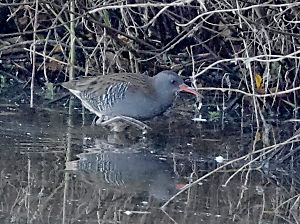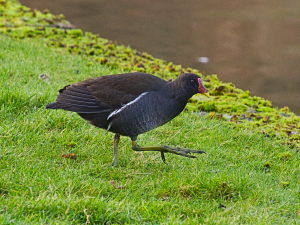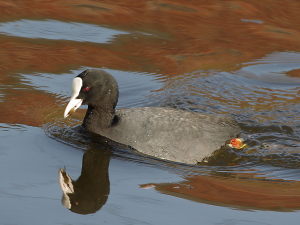


More often heard then seen, especially when the winter migrants arrive in October and when the water levels rise, displacing birds from their established territories. It's a first class skulker with a thin body well adapted to moving through reeds. It will move out of its swampy world in winter when the water freezes or just gets too high for comfort. Two birds, a few years ago, spent a couple of weeks living in culvert under the railway lines at Attenborough during a spell of hard weather.
In Nottinghamshire Water Rails do breed, it is estimated that a few pairs do so. The winter population is much higher and Attenborough for instance has a population in the teens. Sterland classed the Water Rail as uncommon but thought it easy to find in the dykes surrounding fields.

An extremely common water bird in the eighteenth century as well as the twenty-first. It will be happy on any piece of water as long as it has some cover in the form of reeds or hanging willows nearby. It will feed in damp fields, urban parks and canal banks, in autumn it will pick hawthorn berries whilst perched in the bush.
The summer breeding population is probably sedentary, but are joined by immigrants from the continent.

One of our most common water birds. It prefers larger, more open areas of water than the Moorhen, but the two species meet on canals and old gravel pits where the pugnacious Coot easily proves itself as the 'boss'.
The Coot in a natural environment obtains much of its food by diving, but like other successful birds is quiet able to take advantage of any food offered, on purpose or not, by humans.
Again there is a large arrival of Coots from the continent for the winter. Local Coots usually maintain a territory, but the immigrants are more social maintaining large loose flocks.
Any criticisms, corrections or comments to the author Derek Huskisson

This work is licensed under a Creative Commons Attribution-Noncommercial-Share Alike 2.0 UK: England & Wales License.